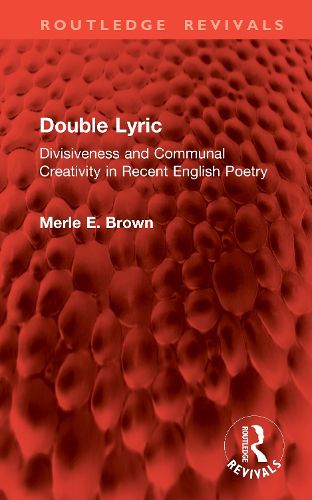Readings Newsletter
Become a Readings Member to make your shopping experience even easier.
Sign in or sign up for free!
You’re not far away from qualifying for FREE standard shipping within Australia
You’ve qualified for FREE standard shipping within Australia
The cart is loading…






Originally published posthumously in 1980, this book centres on 5 British poets - Geoffrey Hill, Philip Larkin, Jon Silkin, Thom Gunn and Charles Tomlinson - and on the emergence in postwar British poetry of 'double-lyrics', poems which have, according to the author 'become two persons, two ways of expressing and attending critically in dramatic divisive conflict.' The nature and significance of the double lyric is first demonstrated by close readings of Silkin's Defence, Tomlinson's Prometheus and Hill's In Piam Memoriam. Further chapters focus on the impressive poems which have arisen out of the stress between ideological commitment and imaginative realization in Silkin's work, the conflict between intuition and perception in the poetry of Tomlinson, and the split between the texture of Gunn's language and the non-verbal experience evoked in his poems. Finally, Merle Brown presents the last phase of F. R. Leavis' collaborative literary and cultural criticism as strikingly close to the poetic achievements of Hill, Silkin, Tomlinson and Gunn.
$9.00 standard shipping within Australia
FREE standard shipping within Australia for orders over $100.00
Express & International shipping calculated at checkout
Originally published posthumously in 1980, this book centres on 5 British poets - Geoffrey Hill, Philip Larkin, Jon Silkin, Thom Gunn and Charles Tomlinson - and on the emergence in postwar British poetry of 'double-lyrics', poems which have, according to the author 'become two persons, two ways of expressing and attending critically in dramatic divisive conflict.' The nature and significance of the double lyric is first demonstrated by close readings of Silkin's Defence, Tomlinson's Prometheus and Hill's In Piam Memoriam. Further chapters focus on the impressive poems which have arisen out of the stress between ideological commitment and imaginative realization in Silkin's work, the conflict between intuition and perception in the poetry of Tomlinson, and the split between the texture of Gunn's language and the non-verbal experience evoked in his poems. Finally, Merle Brown presents the last phase of F. R. Leavis' collaborative literary and cultural criticism as strikingly close to the poetic achievements of Hill, Silkin, Tomlinson and Gunn.